Etiology
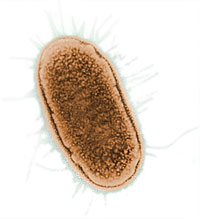 |
|
E. coli
Author: Dr Alan Cann
|
Escherichia coli is an enterobacteria that forms part of the normal intestinal microbiota of healthy animals. Usually, E. coli present in animals are communal antipathogenic strains and they even play a beneficial role, since they compete in several ways with the pathogenic strains in the ecological niche of the lumen.
The term E. coli includes around 200 different serotypes that are classified by their antigens of the cell wall (O antigens), of the capsule, (K antigens) of the fimbriae (F antigens) and of the flagella (H antigens).
The tipification of E. coli with classic methods is being substituted more and more with molecular epidemiology techniques such as pulsed field electrophoresis (PFGE) or the analysis of the variable number of repetitions in tandem (VNTR) which allows us to know with more precision the epidemiology of the illnesses that cause this enterobacteria.
One of the main characteristics of E. coli is its grand capacity to adapt to environmental conditions and experiment change. This is why it acquires a resistance to antibiotics much easier than other bacteria.
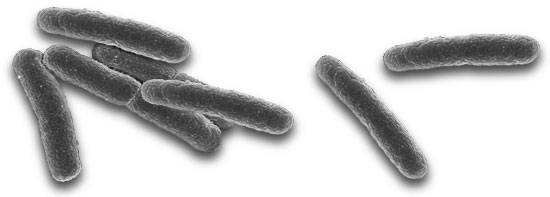
Pathogenesis
Within the adaptive capacity of E. coli is its possibility to use numerous virulence factors that explain the pathogenesis of the illnesses that can cause the pathogenic strains. These virulence factors allow the pathogenic strains to colonize the intestine and compete under advantageous conditions with other bacteria, or with beneficial strains of E. coli.
Some of these virulence factors are not important when it comes to diarrhea in lactating piglets. For example, the production of Shiga toxins is a determining factor of the edema that manifests primarily, after weaning.
Among the main virulence factors in the pathogenesis of diarrhea in lactating piglets, fimbral antigens stand out as they are adhesins that allow E. coli to fix itself to the intestinal wall and multiply massively, as well as the production of enterotoxins.
The virulence factors that E. coli strains have allow for their classification into pathotypes that indicate which factors the strains possess and explain the pathogeny of the illnesses they cause.
Within these pathotypes, the most important pertaining to diarrhea in lactating piglets are the enterotoxigenic E. coli (ETEC) although the enteropathogenic E. coli pathotype (EPEC), also known as the attaching and effacing E. Coli, or AEEC, can also intervene with much less impact.
Enterotoxigenic Escherichia coli (ETEC)
The strains of enterotoxigenic E. coli have adhesins as their main virulence factors. The principal adhesins are actually called F4, F5, F6, F41 and F18 (the first three are what used to be known as K88, K99 and 987P, respectively). These adhesins are immunogenic and, therefore, an important component in vaccines. F18 has only been associated with diarrhea in weaned piglets, therefore its presence isn’t necessary in vaccines for sows that will protect lactating piglets with calostrum. On the other hand, the fimbrial antigen F41 is often found in strain of E. coli that also contain the antigen F5 (K99).
In addition to the fimbrial adhesins, some strains can produce another adhesin called AIDA, implicated in diffuse adhesion.
It must be kept in mind that E. coli evolves based on the pressure of selection it receives. For example, in populations vaccinated against F4(K88), E. coli cannot fix itself to the intestinal wall by way of this adhesin, but it can express others that will allow it to, and in this way easily multiply. For this reason, vaccines have incorporated (and should continue to in the future) the new adhesins that appear in isolated strains in clinical cases, in order to maintain their effectiveness.
As we indicated earlier, in addition to the adhesins, another important virulence factor in lactating piglet diarrhea are toxins.

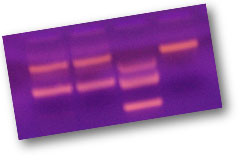 |
|
PCR for toxins Sta, Stb, Lt Autor: Jean Le Guenne |
The enterotoxigenic strains of E.coli produce two principal enterotoxins, one that is heat sensitive (LT) and another that is heat resistant (ST). The LT toxin is divided into two subgroups called LTI and LTII. Only LTI is produced by the E.Coli isolated in swine. The ST toxin has been divided into STa and STb based on its solubility in methanol and its biological activity.
Recently a third enteroaggregative, heat stable toxin has been discovered, called EAST1, whose role in piglet diarrhea has yet to be demonstrated, although it seems to have a pathogenic mechanism similar to that of the STa toxin.
LT is a heavy molecular toxin and easily induces the formation of specific antibodies, which makes it an important component in vaccines. The toxin acts on the enterocytes, activating the adenylate cyclase which stimulates the production of Cl-, Na+ and HCO3- ions and, consequently, diarrhea due to hyper secretion. This in turn, provokes dehydration, acidosis, and in serious cases, death. The feces of affected piglets have an alkaline pH.
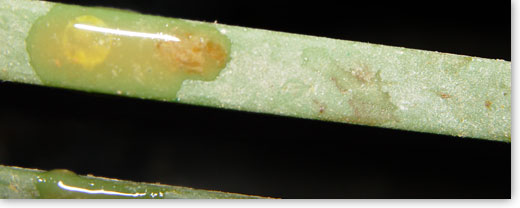
The heat stable STa and STb are small proteins and therefore, are not immunogenic. ST activates guanylate cyclase which stimulates the production of cyclical GMP and this inhibits the co transport system of Na/CI in the intestine and reduces the absorption of electrolytes and water, causing diarrhea. STa is active in piglets under 2 weeks old, and less active in older piglets, probably due to the fact that the change produced by intestinal maturation also produces differences in the concentration of receptors that join themselves to the toxin. STb stimulates the secretion of fluids in the intestine, independent of the cyclical nucleotides and probably in a way that is mediated by prostaglandins. STb is sensitive to trypsin and, therefore, is more active in piglets that are receiving calostrum.
Up until a few years ago, the most common strains of isolated enterotoxigenic E. coli in cases of piglet diarrhea belonged to the serogroups O8, O147, O148 and O157, possessed the fimbria F4(K88) and produced the LTI and STb toxins. Recently the isolation of strains from other serogroups has increased (O8, O9, O64…) that have all or some of the fimbrial antigens, F5 (K99), F6 (987P) and F41 and that principally produce the STa toxin, and in smaller quantities, the STb toxin. These strains cause diarrhea above all in piglets less than one week old while the strains that produce F4 (K88) affect piglets at any age, from birth until after weaning.
Enteropathogenic Escherichia coli (EPEC)
The E. coli strains of this pathotype are also called, as we indicated, attaching and effacing or AEEC, because they cause the illness by joining the enterocytes of the intestinal mucous by way of an external membrane protein called “intimina” or Eae (“Enterotoxigenic E: coli attaching and effacing factor”) destroying the microvillus and invading the cells. The “effacing” of the microvillus considerably diminishes the surface of the enterocytes in the intestine and therefore also alters nutrient digestion and absorption, as well as the absorption of fluids and electrolytes.
The EPEC strains have been associated with a higher frequency of post-weaning diarrhea, but can also intervene in diarrhea during lactation.
Clinical and lesion profile
In some cases, the E. coli strains are so aggressive that the piglets die without ever even having diarrhea, which is the main clinical symptom. This diarrhea has a variable gravity based on the virulence factors of the implied strains, the age of the piglet and its immunological state. It can be more or less aqueous and the color is also variable. The feces do not usually stain the piglets’ perineum and sometimes only irritation is noted, without any fecal remains.
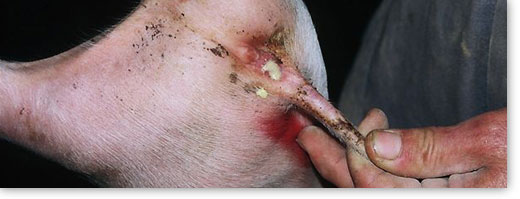
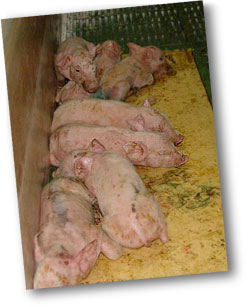 |
| Diarrhea and irritated perianal zone (Source: B&M) |
Diarrhea due to hyper secretion causes dehydration that can cause the piglet to lose up to 40% of its weight and, after advancing, leads to a metabolic acidosis.
In the right conditions, the diarrhea can appear in the first hours after birth, affecting both isolated piglets as well as entire litters. The litters of primiparous sows are in general more affected, as well as low birth weight piglets, which are those that get less calostrum and those that have a lower quality lactation period.
In some cases, vomiting is also present. The piglets are depressed, with a flaccid and sunken abdomen, their hair in a bad state and with a grayish color.
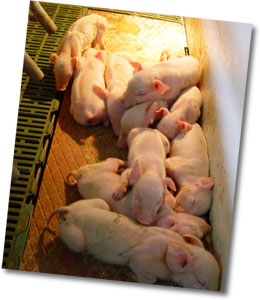 |
| Diarrhea and irritated perianal zone (Source: B&M) |
Prevalence is extremely varied based on the quality of the installations, the immunity of the sows, and the virulence of the strains. The gravity of the diarrhea diminishes as the piglets get older, and mortality is also varied, but it can be extremely high especially in very young piglets (several days old) born of sows without immunity and when treatment is received too late.
There are no specific lesions.
Macroscopically there is dehydration, the stomach is usually full of undigested milk and the small intestine is distended and congested.
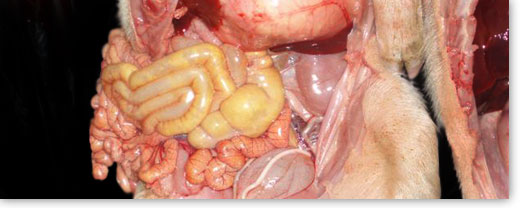
Diagnostic
The clinical profile and the alkalinity of the feces are preliminary, but the diagnostic should be confirmed in a laboratory, isolating and identifying the strains and their virulence factors.
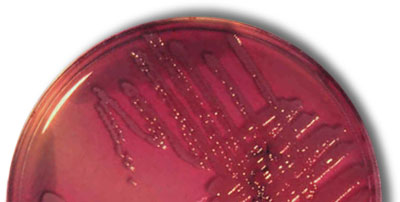
Treatment and prophylaxis
Quick treatment is essential in order for it to be as effective as possible. There are many antibiotics that theoretically, can be very effective against E. coli, but there is also frequently resistance. For that reason, it is a good idea to carry out regular antibiograms that allow us to choose the most effective antibiotics. In general, some quinolones and cephalosporins react well.
Treatments become inefficient on many occasions because the correct doses of the antibiotic are not used, it is not administered at the correct time intervals, or the treatment does not last as long as it should. These errors also notably contribute to the appearance of resistance.
Oral or intraperitoneal administration of fluids with glucose and electrolytes can lessen dehydration and acidosis, and the use of probiotics helps in the recuperation of the affected piglets.
In prophylaxis, environmental conditions are fundamental. Farrowing pens that are clean and at the correct ambient temperature, nesting temperature, ventilation, etc, in general have fewer problems with colibacilosis.
In prophylaxis everything that intervenes in the piglets having the correct amount of calostrum and a high quality lactation period is key. Agalactia or hypogalactia of the sows is a factor that unleashes all sorts of problems in the piglets, among others, diarrhea due to E. coli. An inadequate design of farrowing pens, the scarcity of nipples, cold piglets, humidity, etc, are also predisposing factors.
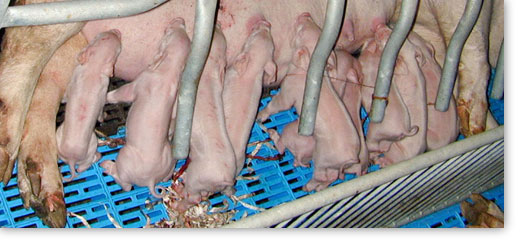
Colibacilosis immunity in piglets is humoral. In the first days of life, the piglet depends on the antibodies it receives from the sows calostrum, and then on the IgA secretions present in milk, until its immune system is capable of reacting. For this reason, as indicated, problems in lactation are very important.
Vaccination of sows is one of the most efficient measures used to prevent colibacilosis in lactating piglets. There are many diverse vaccines against colibacilosis. On the market, there are bacterines that contain strains of the principal O serogroups, fimbrial antigens and enterotoxins, and other subunit vaccines that contain fimbrial antigens and purified enterotoxins.
The vaccination of sows 6-8 weeks before giving birth, and the re-vaccination 2-3 weeks beforehand, induces high latcogenic immunity capable of adequately protecting the piglet during the first weeks of life, which is when they are the most receptive.
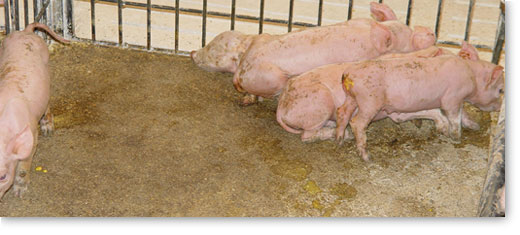
However, vaccination cannot substitute measures involved in adequate housing, handling, and lactation.
In farrowing pens that are dirty, humid, and in poor conditions, the pressure of the infection can override vacunal immunity. In this same way, when there are problems with agalactia or hypogalactia in sows, the piglet doesn’t receive the antibodies generated by the calostrum and the milk, or they receive an insufficient amount, and therefore, can be unprotected. In large litters, or first time litters, there can be piglets that do not suck enough and those are the ones that will have diarrhea. The cold also notably affects the vitality of the piglets and can contribute to them not sucking enough, and therefore become an important auxiliary factor in colibacilar diarrhea.
When some piglets, due to problems with handling, housing, or lactation, suffer from diarrhea the pressure of infection on the other piglets in the litter is increased and will easily spread to others.


